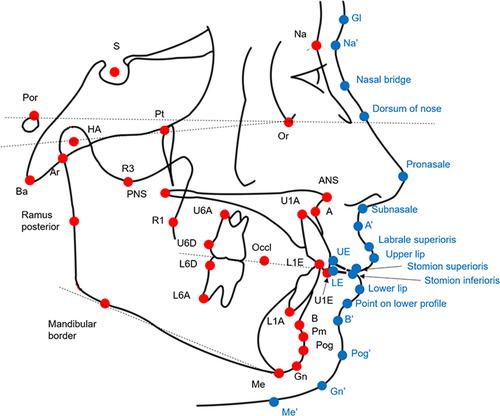Accuracy of artificial intelligence-assisted growth prediction in skeletal Class I preadolescent patients using serial lateral cephalograms for a 2-year growth interval
Abstract
Objective
To investigate the accuracy of artificial intelligence-assisted growth prediction using a convolutional neural network (CNN) algorithm and longitudinal lateral cephalograms (Lat-cephs).
Materials and Methods
A total of 198 Japanese preadolescent children, who had skeletal Class I malocclusion and whose Lat-cephs were available at age 8 years (T0) and 10 years (T1), were allocated into the training, validation, and test phases (n = 161, n = 17, n = 20). Orthodontists and the CNN model identified 28 hard-tissue landmarks (HTL) and 19 soft-tissue landmarks (STL). The mean prediction error values were defined as ‘excellent,’ ‘very good,’ ‘good,’ ‘acceptable,’ and ‘unsatisfactory’ (criteria: 0.5 mm, 1.0 mm, 1.5 mm, and 2.0 mm, respectively). The degree of accurate prediction percentage (APP) was defined as ‘very high,’ ‘high,’ ‘medium,’ and ‘low’ (criteria: 90%, 70%, and 50%, respectively) according to the percentage of subjects that showed the error range within 1.5 mm.
Results
All HTLs showed acceptable-to-excellent mean PE values, while the STLs Pog’, Gn’, and Me’ showed unsatisfactory values, and the rest showed good-to-acceptable values. Regarding the degree of APP, HTLs Ba, ramus posterior, Pm, Pog, B-point, Me, and mandibular first molar root apex exhibited low APPs. The STLs labrale superius, lower embrasure, lower lip, point of lower profile, B′, Pog,’ Gn’ and Me’ also exhibited low APPs. The remainder of HTLs and STLs showed medium-to-very high APPs.
Conclusion
Despite the possibility of using the CNN model to predict growth, further studies are needed to improve the prediction accuracy in HTLs and STLs of the chin area.


 求助内容:
求助内容: 应助结果提醒方式:
应助结果提醒方式:


